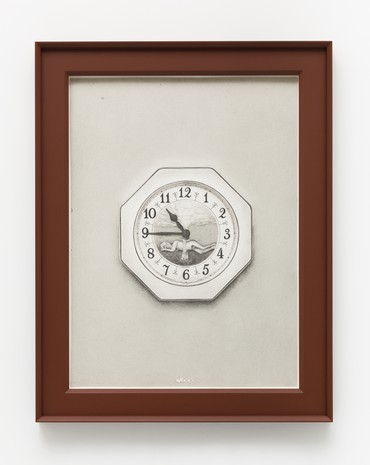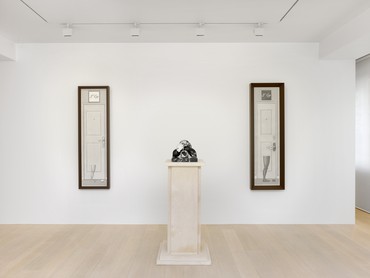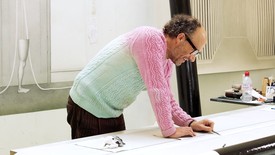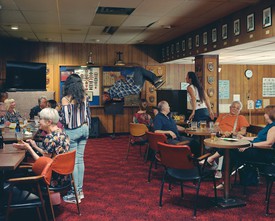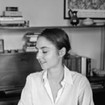
Anna Heyward is a writer and editor in New York. Her work has appeared in The New York Times, The New Yorker, Vogue, and The Paris Review Daily, among others.
Almost all art is against time.
—Paul Noble
Paul Noble’s encrypted visual universes are rendered almost exclusively in hard graphite pencil, using language as image, and images as grammatical systems. His meticulously depicted, interlocking words and objects create legible syntaxes, presenting a reality that appears recognizably of our world—but is not.
In 1995 Noble began Nobson Newtown, a series of drawings depicting an imagined city of the same name. In the following years, Nobson became an immersive realm, one that seems to live on beyond the edges of the drawings. Noble was nominated for the Turner Prize for the series in 2012, and while it may never be complete, it seemed to reach a kind of critical mass in 2014, when the Museum Boijmans Van Beuningen in Rotterdam brought together twenty-three enormous pencil drawings, allowing the first unified look at the surreal and novelistic universe of Nobson. With its hospitals, utilities, and unique local vernacular, it bears a resemblance to the planned towns that were constructed in midcentury Britain, and to the London in which Noble lived during the 1990s.
This November and December, Gagosian presents an installation of works by Noble to coincide with an exhibition of his work at the Musée des Beaux-Arts in La Chaux-de-Fonds, Switzerland. David Lemaire, curator of the Musée des Beaux-Arts presentation, notes that Nobson “shares numerous similarities with the city of La Chaux-de-Fonds: a certain isolation, a taste for sharp right angles, modernist architecture, and strange public sculptures. The exhibition was conceived with the artist for its resonance with the city.”
Both Gagosian’s installation and the concurrent museum exhibition include drawings from the Nobson Newtown series along with selections of Noble’s recent work, made since 2015. The new works unfold within flat, planar settings, devoid of the epic scale and spatial breadth that have characterized Noble’s past drawings. The environment they present moves the viewer out of the panoptic range of Nobson and into a tightly confined, almost airless interior space. It is as though, after creating the vastness of an entire city, Noble has telescoped in on a single house, room, doorway, or object.
While the large works of Nobson Newtown were unframed, reinforcing their sense of vastness, these drawings are encased within heavy wooden frames of Noble’s own design, which often echo the framed images within the drawings themselves. In this way, the suggestion—latent in Noble’s work—that a drawing can also be a sculpture emerges.
Characterized by a flatness of perspective and a uniformity of light, these pictures contain certain recurring motifs: a leg, large and incongruous like a divine icon; mysterious doors, always concealing whatever is behind them; and clocks that stand still at 10:45—the time at which, Noble says, Nobson was created, suggesting a surreal providence and forming a continuation between the two series of work. Scale tends to shift throughout these interiors, ranging from the minuscule to the gigantic according to an opaque logic at odds with physical reality.
This feeling of the strangely familiar, preternatural, or unsettling, reminiscent of Surrealism, resonates in Noble’s drawings, with their quietly decontextualized objects.
Legs stand before doors, in corridors, entryways, or other interior settings. Oriented toward the right of the picture’s edge, their form seems to conform with a character being read in left-to-right Latin script. Appearing with other objects—a clock, a cane, a feather, an egg—the inscrutable limbs suggest human presence, though they remain uncannily disconnected. This feeling of the strangely familiar, preternatural, or unsettling, reminiscent of Surrealism, resonates in Noble’s drawings, with their quietly decontextualized objects.
Each drawing contains encoded repetitions. Door handles are flat, open hands; keyholes take the same shape as the leg. The magician’s wand depicted in WHAM (2016–17) sits, larger than life-size, in a horizontally oriented frame. The wand, like a typographical dash, or a line made on a page, serves as a mediator, connecting elements that had no previous relationship. In magic, the wand does what a pencil does on paper, causing things to appear from nothing.
Just as Nobson developed from a typographical font—the staffs and stems of the letters making up the architectural elements of the city—this space has a peculiarly symbiotic relationship with words, too. With his titles, Noble exploits the sound of the lexeme, as well as what it signifies, with visual and homophonic puns. C’_OCK (2016), for instance, shows six clocks decreasing in size from left to right. Its title, employing an apostrophe and an underscore, makes the alphabetic character L into an image, and physically extends the word clock to the same number of glyphs as there are clocks depicted. L’Arge D’Oor (2015), meanwhile, is an overt pun on Luis Buñuel’s surrealist film L’age d’or (1930).
This affinity between the object and the word makes the acts of seeing and reading simultaneous, in that the viewer decodes at the same time that she perceives, uncovering subconscious preexisting connections. This is fitting, given that there is a sense that Noble’s task has only been to slowly reveal the universe he depicts rather than to create it—that it has always existed and that it is just now being shown to us.
Artwork © Paul Noble; Paul Noble: Open Shut, Musée des Beaux-Arts, La Chaux-de-Fonds, Switzerland, November 4, 2018–February 3, 2019; Paul Noble, Gagosian, Geneva, November 6–December 15, 2018



